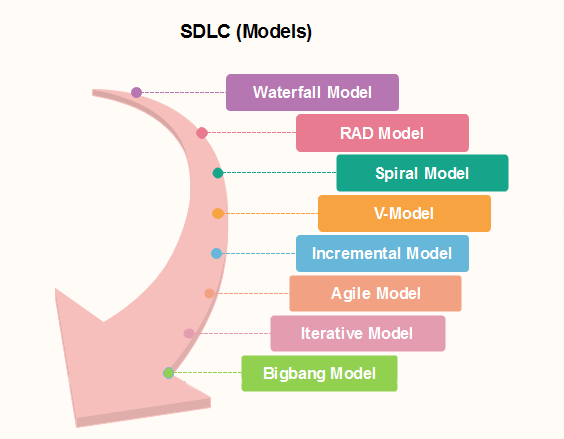Software Development Life Cycle (SDLC)#
The Software Development Life Cycle (SDLC) is an organized process that provides a structured approach for developing software. It serves as a roadmap for developers, helping them move from the conceptual stage to the product’s retirement in a disciplined and systematic manner.
Need for SDLC#
Systematic Approach: SDLC introduces order to what can otherwise be a chaotic development process.
Clear Milestones: With entry and exit criteria defined for each phase, the progress of the project is easier to track.
Risk Mitigation: The structured approach enables identification of issues early in the development process, reducing the risk of late project failure.
Resource Management: SDLC enables efficient allocation and utilization of resources, including time and human expertise.
The Stages of SDLC#

Stage 1: Planning and Requirement Analysis#
The inception of any software development effort lies in understanding what needs to be built. This involves consultation with stakeholders, domain experts, and potential end-users. Important outcomes of this stage include risk assessment, quality assurance planning, and the creation of the Software Requirement Specification (SRS) document.
Stage 2: Defining Requirements#
Post requirement analysis, an SRS document is compiled, listing in detail the requirements of the software. It serves as the definitive guide for developers and should be reviewed and approved by all stakeholders.
Stage 3: Designing the Software#
Based on the SRS, the architecture of the software is crafted. This phase defines how the system will be structured, which algorithms to use, and what interfaces will be exposed.
Stage 4: Developing the Project#
The actual codebase of the software is developed in this phase. Adherence to coding guidelines and other best practices is crucial to ensure maintainability and scalability.
Stage 5: Testing#
Upon completion of the development, rigorous testing is performed. This can include unit testing, integration testing, system testing, and acceptance testing to ensure the software meets the stated requirements.
Stage 6: Deployment#
Once the software has been tested and certified, it moves to the deployment stage where it becomes accessible to end-users.
Stage 7: Maintenance#
After the software has been deployed, it enters a maintenance phase, where bugs are fixed, and updates are rolled out to ensure it continues to meet user needs and operate efficiently.
Software Development Life Cycle Models#

The Software Development Life Cycle (SDLC) is a conceptual framework that serves as a guide for the production and maintenance of high-quality software. Different models of SDLC are suited for various types of projects, and each has its own specific phases and activities.
Waterfall Model#
Characteristics: Sequential and non-iterative, activities flow like a waterfall.
Advantages: Simple and well-understood, straightforward phases.
Limitations: Difficult to accommodate changes, risky if requirements aren’t well-understood.
RAD Model#
Characteristics: Adaptation of the Waterfall model, focused on rapid development.
Advantages: Quick market entry, user involvement ensures a better end product.
Limitations: Requires strong team coordination, not suitable for large projects.
Spiral Model#
Characteristics: Risk-driven, combines elements of Waterfall and prototypes.
Advantages: Effective risk management, adaptable to evolving requirements.
Limitations: Complexity, cost and time can spiral if not managed well.
V-Model#
Characteristics: Testing and development occur in parallel.
Advantages: Ensures robustness and reliability.
Limitations: Inflexible, rigidly structured.
Incremental Model#
Characteristics: Series of mini-Waterfalls, adds functionality incrementally.
Advantages: Partial systems are quickly built, easier to test and debug.
Limitations: Needs a clear and complete definition of the system.
Agile Model#
Characteristics: Iterative, accommodates changing requirements.
Advantages: Fast, adaptive, customer-focused.
Limitations: Can lack a coherent architectural vision, not suitable for all types of projects.
Iterative Model#
Characteristics: Simplified initial implementations, complexity added iteratively.
Advantages: Easier to test and debug, client feedback incorporated.
Limitations: May require more resources, prone to scope creep.
Big Bang Model#
Characteristics: Minimal planning, mainly coding.
Advantages: Flexible and creative.
Limitations: Risky, uncontrolled, and often leads to chaos.
Prototype Model#
Characteristics: Initial prototype built and improved through iterations.
Advantages: Incorporates user feedback, allows refinement.
Limitations: May result in insufficiently analyzed systems, can become too focused on visible qualities.
Summary#
The choice of SDLC model can significantly impact the success of a software development project. It’s essential to match the model to the specific requirements, constraints, and risks of the project. No one-size-fits-all solution exists. Therefore, it’s possible to consider a hybrid approach that combines the strengths of two or more models. Additionally, an evolving trend is the use of AI in SDLC to predict risks, automate testing, and optimize various aspects of software development, potentially reshaping our understanding of how best to implement these models.